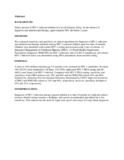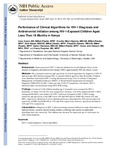| dc.contributor.author | Inwani, Irene | |
| dc.contributor.author | Mbori-Ngacha, DA | |
| dc.contributor.author | Nduati, RW | |
| dc.contributor.author | Obimbo, E | |
| dc.contributor.author | Wamalwa, Dalton | |
| dc.contributor.author | John-Stewart, G | |
| dc.contributor.author | Farquhar, C | |
| dc.date.accessioned | 2013-04-29T08:24:45Z | |
| dc.date.available | 2013-04-29T08:24:45Z | |
| dc.date.issued | 2009-04 | |
| dc.identifier.citation | Journal of Acquired Immune Deficiency Syndrom. 2009;50(5): 492-498 | en |
| dc.identifier.uri | http://www.ncbi.nlm.nih.gov/pubmed/19225401 | |
| dc.identifier.uri | http://erepository.uonbi.ac.ke:8080/xmlui/handle/123456789/17496 | |
| dc.identifier.uri | http://journals.lww.com/aidsonline/Fulltext/2012/09240/Performance_of_the_integrated_management_of.10.aspx | |
| dc.description | Journal article | en |
| dc.description.abstract | Background
Ninety percent of HIV-1-infected children live in sub-Saharan Africa. In the absence of diagnosis and antiretroviral therapy (ART), approximately 50% die before 2 years.
Methods
We evaluated sensitivity and specificity of clinical algorithms for diagnosis of HIV-1 infection and ART initiation among HIV-1-exposed children aged less than 18 months. Children were identified with routine HIV-1 testing and assessed using 3 sets of criteria: 1) Integrated Management of Childhood Illnesses (IMCI), 2) World Health Organization Presumptive Diagnosis (WHO-PD) for HIV-1 infection, and 3) CD4 T-lymphocyte cell subsets. HIV-1 infection status was determined using DNA PCR testing.
Findings
A total of 1,418 children (median age 5.4 months) were screened for HIV-1 antibodies, of whom 144 (10.2%) were seropositive. Of these, 134 (93%) underwent HIV-1 DNA testing and 80 (60%) were found to be HIV-1-infected. Compared to HIV-1 DNA testing, sensitivity and specificity of the IMCI were 19% and 96% and for WHO-PD criteria 43% and 88%, respectively. Inclusion of severe immune deficiency determined by CD4 percent improved sensitivity of IMCI and WHO-PD to 74% and 84% respectively, however, specificity declined to 43% and 41%, respectively.
Interpretation
Diagnosis of HIV-1 infection among exposed children less than 18 months in a high prevalence, resource-limited setting remains a challenge and current recommended algorithms have low sensitivity. This underscores the need for rapid scale-up of viral assays for early infant diagnosis. | en |
| dc.language.iso | en | en |
| dc.subject | Performance | en |
| dc.subject | Clinical Algorithms | en |
| dc.subject | HIV-1 Diagnosis | en |
| dc.subject | Antiretroviral Initiation | en |
| dc.subject | HIV-1-Exposed Children | en |
| dc.subject | Kenya | en |
| dc.title | Performance of Clinical Algorithms for HIV-1 Diagnosis and Antiretroviral Initiation among HIV-1-Exposed Children Aged Less Than 18 Months in Kenya | en |
| dc.type | Article | en |
| local.publisher | Department of paediatrics, University of Nairobi | en |


